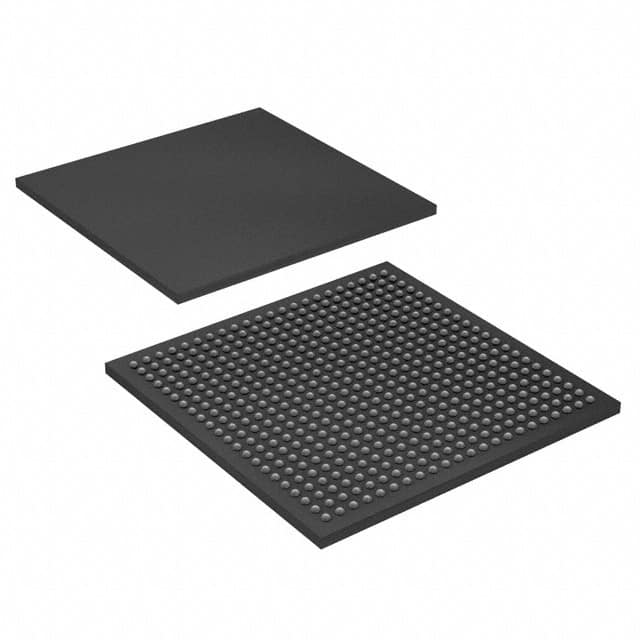EP1S10F484C5N
Product Overview
- Category: Programmable Logic Device (PLD)
- Use: EP1S10F484C5N is a PLD used for digital logic design and implementation.
- Characteristics: It offers high-speed performance, low power consumption, and flexibility in designing complex digital circuits.
- Package: The EP1S10F484C5N comes in a 484-pin FineLine BGA package.
- Essence: It is designed to provide efficient and reliable programmable logic solutions for various applications.
- Packaging/Quantity: The EP1S10F484C5N is typically sold individually or in reels of multiple units.
Specifications
- Logic Elements: The device contains 10,000 logic elements, which can be configured as look-up tables, registers, or flip-flops.
- Memory: It includes 288 kilobits of embedded memory for storing data.
- I/O Pins: The EP1S10F484C5N has 316 I/O pins for interfacing with external devices.
- Clocking: It supports up to four global clock signals and provides advanced clock management features.
- Operating Voltage: The device operates at a voltage range of 1.2V to 3.3V.
- Speed Grade: EP1S10F484C5N is available in different speed grades, ranging from 250MHz to 500MHz.
Pin Configuration
The EP1S10F484C5N has a detailed pin configuration, which can be found in the manufacturer's datasheet.
Functional Features
- Programmability: EP1S10F484C5N offers extensive programmability, allowing users to implement custom logic functions.
- High-Speed Performance: The device delivers high-speed performance, making it suitable for applications that require quick response times.
- Low Power Consumption: It is designed to minimize power consumption, making it energy-efficient.
- Flexible I/O Options: The PLD provides a wide range of I/O options, enabling easy integration with other components.
- Advanced Clock Management: EP1S10F484C5N includes advanced clock management features, allowing precise control over timing requirements.
Advantages and Disadvantages
Advantages: - High-speed performance - Low power consumption - Flexible programmability - Advanced clock management
Disadvantages: - Limited logic elements compared to larger PLDs - Higher cost compared to simpler programmable devices
Working Principles
EP1S10F484C5N operates based on the principles of digital logic design. It utilizes configurable logic elements and memory blocks to implement desired logic functions. The device can be programmed using hardware description languages or graphical design tools, which generate configuration files that are loaded onto the PLD.
Application Field Plans
EP1S10F484C5N finds applications in various fields, including: - Telecommunications: Used in network routers, switches, and communication equipment. - Industrial Automation: Employed in control systems, motor drives, and robotics. - Automotive: Integrated into automotive electronics for functions like engine control and driver assistance systems. - Consumer Electronics: Utilized in smart TVs, gaming consoles, and multimedia devices. - Aerospace and Defense: Applied in avionics, radar systems, and military equipment.
Alternative Models
- EP1S20F484C5N: A higher-capacity version with 20,000 logic elements.
- EP1S30F484C5N: An even larger variant with 30,000 logic elements.
- EP1S05F484C5N: A lower-cost option with 5,000 logic elements.
These alternative models offer different logic capacities to cater to varying design requirements.
Note: The content provided above is a sample and may not reflect the actual specifications or details of EP1S10F484C5N. Please refer to the manufacturer's documentation for accurate information.
技術ソリューションにおける EP1S10F484C5N の適用に関連する 10 件の一般的な質問と回答をリストします。
Sure! Here are 10 common questions and answers related to the application of EP1S10F484C5N in technical solutions:
Q1: What is EP1S10F484C5N? A1: EP1S10F484C5N is a specific model of Field-Programmable Gate Array (FPGA) manufactured by Intel. It offers programmable logic and high-speed I/O capabilities.
Q2: What are the key features of EP1S10F484C5N? A2: Some key features include 10,000 logic elements, 484-pin package, 5V tolerant I/Os, embedded memory blocks, and support for various communication protocols.
Q3: What are the typical applications of EP1S10F484C5N? A3: EP1S10F484C5N can be used in a wide range of applications such as industrial automation, telecommunications, automotive systems, medical devices, and video processing.
Q4: How can EP1S10F484C5N be programmed? A4: EP1S10F484C5N can be programmed using hardware description languages (HDL) like VHDL or Verilog, which allow designers to describe the desired functionality of the FPGA.
Q5: Can EP1S10F484C5N be reprogrammed after initial programming? A5: Yes, EP1S10F484C5N is a reprogrammable FPGA, meaning that it can be reconfigured multiple times to implement different designs or make updates to the existing design.
Q6: What tools are available for designing with EP1S10F484C5N? A6: Intel provides Quartus Prime software suite, which includes design entry, synthesis, simulation, and programming tools specifically tailored for programming and configuring EP1S10F484C5N.
Q7: What are the power requirements for EP1S10F484C5N? A7: EP1S10F484C5N operates at a core voltage of 3.3V and requires additional power supplies for I/O banks, which can vary depending on the specific application and configuration.
Q8: Can EP1S10F484C5N interface with other components or devices? A8: Yes, EP1S10F484C5N supports various communication protocols such as UART, SPI, I2C, and Ethernet, allowing it to interface with other components or devices in a system.
Q9: Are there any limitations or considerations when using EP1S10F484C5N? A9: Some considerations include power consumption, heat dissipation, timing constraints, and the need for proper grounding and decoupling techniques to ensure reliable operation.
Q10: Where can I find more information about EP1S10F484C5N? A10: You can refer to the official documentation provided by Intel, including datasheets, user guides, and application notes, which provide detailed information about EP1S10F484C5N's features and usage guidelines.
Please note that the answers provided here are general and may vary based on specific design requirements and implementation details.


